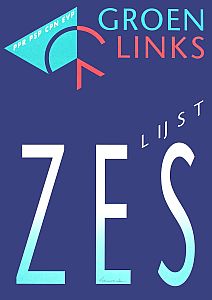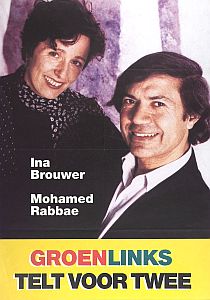- This page was last modified on 17 October 2025, at 10:18. Suggest an edit.
GroenLinks facts for kids
| <div style="padding-top:0.3em; padding-bottom:0.3em; border-top:2px solid Lua error in Module:European_and_national_party_data/config at line 227: attempt to index field 'data' (a nil value).; border-bottom:2px solid Lua error in Module:European_and_national_party_data/config at line 227: attempt to index field 'data' (a nil value).; line-height: 1;">
GroenLinks
GroenLinks
|
|
|---|---|
| Abbreviation | GL |
| Leader | Jesse Klaver (list) |
| Chair | Katinka Eikelenboom |
| Leader in the Senate | Paul Rosenmöller (GL–PvdA) |
| Leader in the House of Representatives | Frans Timmermans (GL–PvdA) |
| Leader in the European Parliament | Bas Eickhout |
| Founded | 24 November 1990 (as a party) |
| Merger of | Rainbow: PSP, CPN, PPR and EVP |
| Headquarters | Partijbureau GroenLinks Sint Jacobsstraat 12, Utrecht |
| Think tank | Bureau de Helling |
| Youth wing | DWARS |
| Membership (January 2025) | |
| Ideology | |
| Political position | Centre-left to left-wing |
| National affiliation | GroenLinks–PvdA |
| Regional affiliation | Socialists, Greens and Democrats |
| European affiliation | European Green Party |
| International affiliation | Global Greens |
| European Parliament group | Greens–European Free Alliance |
| Colours | Green Red |
| Senate | Lua error in Module:European_and_national_party_data/config at line 227: attempt to index field 'data' (a nil value). |
| Provincial councils |
49 / 570
|
| European Parliament | Lua error in Module:European_and_national_party_data/config at line 227: attempt to index field 'data' (a nil value). |
| King's Commissioners |
0 / 12
|
| Benelux Parliament |
2 / 21
|
| Website | |
| Lua error in Module:European_and_national_party_data/config at line 227: attempt to index field 'data' (a nil value). | |
GroenLinks (pronounced khroon-links), which means GreenLeft in English, is a green political party in the Netherlands. Its abbreviation is GL.
The party was formed on 1 March 1989. It was a merger of four smaller left-wing parties. These parties were the Communist Party of the Netherlands, the Pacifist Socialist Party, the Political Party of Radicals, and the Evangelical People's Party. They all shared progressive ideas, meaning they wanted to make society better through new ideas and reforms.
GroenLinks describes itself as "green," "social," and "tolerant." This means it cares a lot about protecting the environment, making sure society is fair for everyone, and accepting people's differences. The party is most popular in big cities, especially cities with universities.
Since 2021, GroenLinks has been working very closely with the Labour Party (PvdA). They formed an alliance called GroenLinks–PvdA and even ran in the 2023 general election with one shared list of candidates. Together, they have a group of 25 seats in the Dutch parliament.
Contents
History of GroenLinks
How the Party Began
Before 1989, there were four separate "small left" parties in the Netherlands. They were called "small" because they didn't have many seats in parliament. These parties were:
- The Communist Party of the Netherlands (CPN)
- The Pacifist Socialist Party (PSP), which grew out of the peace movement.
- The Political Party of Radicals (PPR), which started as a progressive Christian party.
- The Evangelical People's Party (EVP), another progressive Christian party.
Starting in the 1980s, these four parties began to work together. They realized that by joining forces, they could have a bigger impact. They often met at protests against nuclear power and nuclear weapons. In 1989, they decided to run together in the European Parliament election under the name "Rainbow."
Later that year, they created a single list of candidates for the Dutch general election. This new group was called GroenLinks. The name was a mix of "Groen" (Green), which was important to the PPR, and "Links" (Left), which was important to the CPN and PSP. The party was officially founded on 24 November 1990, when the four original parties were formally ended.
Early Years in Parliament
In the 1989 election, GroenLinks won six seats in parliament, which was double what its founding parties had together before. This success encouraged them to continue as one party.
The early years were about figuring out the party's main ideas. It was a challenge because the founding parties came from different backgrounds, from communism to progressive Christianity. The new party had to find a way to combine all these views.
One of the party's first big moments was opposing the Gulf War. GroenLinks was the only party in the Dutch parliament to do so. This showed their commitment to peace, a core value from the Pacifist Socialist Party.
Growing as an Opposition Party
After a tough election in 1994, Paul Rosenmöller became the party's leader. He was very popular and became known as the "unofficial leader" of the opposition. An opposition party is a party that is not in the government and challenges the government's decisions. Rosenmöller's strategy was to not just say "no" to the government, but to offer good alternatives.
This strategy worked well. In the 1998 election, GroenLinks more than doubled its seats, going from five to eleven. This was a huge success for the party.
The party faced difficult decisions during this time, such as whether to support military actions in Kosovo and Afghanistan. These issues caused a lot of debate within the party, as many members had strong pacifist (anti-war) beliefs.
Recent History and New Leaders
In 2002, after a period of intense political change in the Netherlands, Paul Rosenmöller left politics. He said that ongoing threats to his family's safety were the main reason. Femke Halsema took over as the new leader. Under her leadership, the party focused on ideas like individual freedom, tolerance, and personal growth.
After the 2010 election, Halsema stepped down and was replaced by Jolande Sap. The 2012 election was very difficult for the party, and it lost many seats. This led to another change in leadership, with Bram van Ojik taking over, followed by Jesse Klaver in 2015.
Under Jesse Klaver's leadership, the party made a big comeback. In the 2017 election, GroenLinks won a record high of 14 seats. After the 2021 election, GroenLinks and the Labour Party (PvdA) started working together more closely. They ran together in the 2023 election with Frans Timmermans as their lead candidate and won 25 seats, becoming the second-largest group in parliament.
What GroenLinks Believes In
Core Ideas
The main ideas of GroenLinks are written in a document called the "Party for the Future." The party's beliefs are a mix of green and left-wing ideas. Their key principles are:
- Protecting the Earth: This includes caring for nature, ecosystems, and treating animals with respect.
- Fairness for All: The party wants to share the world's resources fairly among all people and future generations. They also want everyone to have a fair chance at a good job, education, and healthcare.
- An Open Society: GroenLinks believes in a society where everyone is free to be themselves and can participate fully.
- Peace and Human Rights: They want to strengthen international laws to protect peace and human rights around the world.
Key Proposals
GroenLinks has many specific ideas for how to improve the Netherlands. Here are some of them:
Environment and Climate
GroenLinks wants to fight climate change by switching to clean energy. They want to use taxes and other rules to encourage the use of solar and wind power instead of fossil fuels. The party also wants to close all nuclear power plants in the Netherlands. To reduce traffic and pollution, they want to invest in better public transport, like trains and buses.
Economy and Work
The party wants to reform the welfare state, which is the system of government support for people who are unemployed or sick. They want to help people who have a hard time finding jobs, such as young people, single parents, and people with disabilities. They also want to lower taxes on work, especially for lower-paid jobs, and increase taxes on pollution. This is called a "green tax shift."
Society and Freedom
GroenLinks values individual freedom. They want to protect people's privacy online and support an open and tolerant society. The party also supports fair policies for immigrants and people seeking asylum. In the long term, they would like the Netherlands to become a republic, which means it would no longer have a monarchy (a king or queen).
Election Results
Here is a look at how many seats GroenLinks has won in the Dutch House of Representatives (the main part of parliament) over the years. There are 150 seats in total.
- 1989: 6 seats
- 1994: 5 seats
- 1998: 11 seats
- 2002: 10 seats
- 2003: 8 seats
- 2006: 7 seats
- 2010: 10 seats
- 2012: 4 seats
- 2017: 14 seats
- 2021: 8 seats
In the 2023 election, GroenLinks ran together with the Labour Party (PvdA). Their combined list, GroenLinks–PvdA, won 25 seats.
Party Organization
GroenLinks is a democratic party where members have a say. The highest power in the party is the congress, which is a big meeting open to all members. The congress elects the party's board and decides on the party's platform and candidates for elections.
The party has several related organizations:
- DWARS: The independent youth organization of GroenLinks.
- Bureau de Helling: The party's think tank, which studies important issues and publishes a magazine.
- PinkLeft: An organization for LGBT members of the party.
GroenLinks is also part of international groups, like the European Green Party and the Global Greens, where it works with other green parties from around the world.
Images for kids
See also
 In Spanish: Izquierda Verde (Países Bajos) para niños
In Spanish: Izquierda Verde (Países Bajos) para niños
- List of Members of the House of Representatives of the Netherlands for GreenLeft
- Green party
- Green politics
- List of environmental organizations








